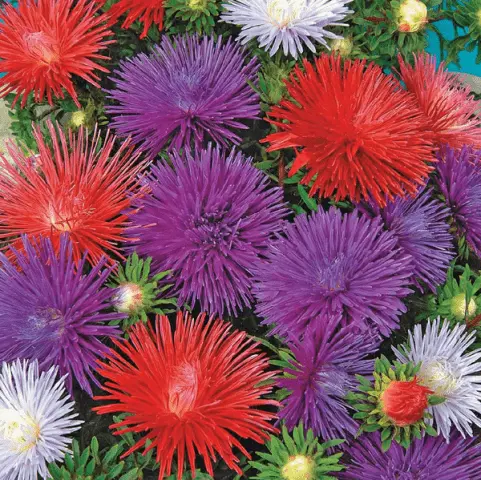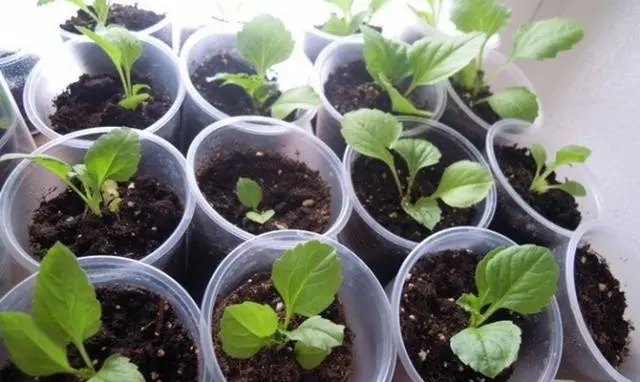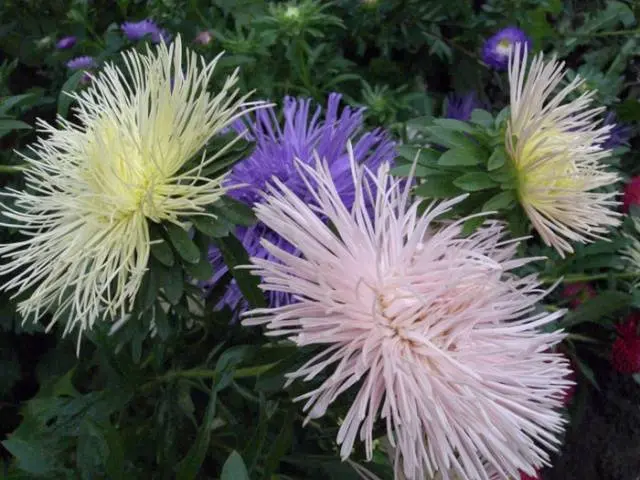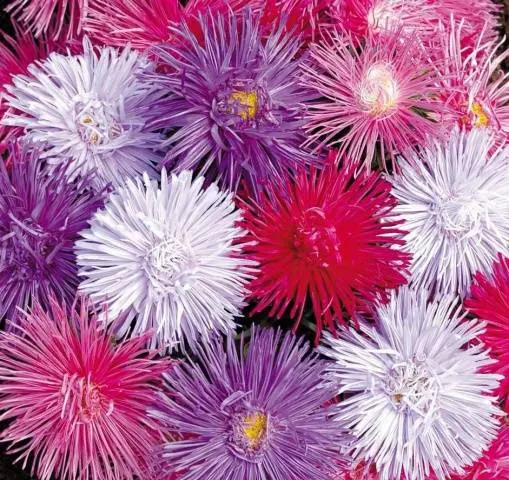Contents
Needle asters will decorate autumn flower beds in the garden and flower arrangements. Plants are annuals and require harvesting at the end of the season. For landing choose a lighted place on a hill.
The flower is resistant to low temperatures, easily tolerates short-term drought. For abundant flowering, it is enough to water the plantings and periodically apply mineral fertilizers.
Description
Aster needle-shaped Unicum mix includes several varieties that differ in the shade of inflorescences. Plants have a pyramidal shape, reach a height of 50-70 cm.
Inflorescences solitary, flat, radial, densely double. The size of the flowers is up to 15 cm. Each bush produces about 10-12 shoots and 30 inflorescences during the growing season.
The color range of needle asters is extensive and includes the following shades:
- white;
- purple;
- red;
- pink;
- yellow;
- coral.
Aster needle is distinguished by early flowering. The first buds appear 3-4 months after germination. Flowering is long, continuous for 50 days from July to September.
Asters are light-loving plants resistant to short frosts down to -4 °C. They are used to decorate multi-flowered and single flower beds, mixborders and borders. The plant will decorate country and city flower beds.
At home, the aster is planted in pots, which are kept on well-lit balconies or loggias.
Needle varieties are grown for cutting. Flowers stand in water for 14 days. From them create monophonic or contrasting bouquets. Asters look spectacular in combination with greenery.
In the photo, aster needle Unicum mix:

Seedbed method
Needle aster is grown by seedlings. Seeds are planted in a prepared substrate at home. Seedlings provide the necessary microclimate. The grown seedlings are transferred to open areas.
Seed and soil preparation
When growing needle aster, seeds are planted from March to April. For planting use light fertile soil. The soil is taken from the summer cottage and fertilized with humus. It is allowed to use purchased land intended for seedlings.
The soil is pre-treated for the purpose of disinfection. It is steamed in a water bath or left for several weeks in the cold. Before planting, the soil is watered with a warm solution of potassium permanganate.
To obtain seedlings, take boxes or cassettes with a cell size of 3-5 cm. When using cassettes or individual cups, you can avoid picking seedlings.
The soil is moistened and poured into containers. Aster seeds are deepened by 1 cm, a thin layer of earth is poured on top. 2-3 seeds are placed in cassettes. Landings are covered with polyethylene to create a greenhouse effect.
Seed germination takes 10-14 days. The film is periodically turned over to ensure the supply of fresh air. The soil is moistened with warm water. Seeds harvested a year earlier germinate faster.
Care of seedlings
When shoots appear, the polyethylene is removed, and the containers are moved to a lighted place. The development of needle aster seedlings occurs when a number of conditions are met:
- temperature regime 16-18 °С;
- regular watering;
- lack of stagnant moisture and drafts;
- lighting for 12-14 hours.
Seedlings of needle varieties are watered with warm water from a spray bottle. Install lighting if necessary. Fitolamps are used for it, which are located at a distance of 30 cm from the plants.
In the photo, seedlings of needle aster Unicum mix:

When the first and second leaves appear, the asters are seated in separate containers. When growing flowers in a cassette, the most developed plant is chosen.
3 weeks before transfer to the ground, the plants are subjected to hardening. Containers with seedlings are rearranged on a balcony or loggia for several hours. Consistently, the period of stay of asters in the fresh air is increased.
Landing in the ground
Asters are transferred to open ground at the age of 60-65 days. A plot for a flower garden is prepared in the fall. It is dug up and fertilized with humus.
Asters prefer well-drained light soils. When growing in heavy clay soil, coarse sand is necessarily introduced. The flower garden is not equipped in the lowlands, where moisture accumulates.
Planting holes are prepared in the garden, where the plants are transferred. 30 cm is left between them. Aster roots are covered with earth and abundant watering is carried out.
seedless way
In regions with a warm climate, asters are planted immediately in open ground. Under natural conditions, growing needle aster from seeds takes longer, so the timing of flowering also shifts. When planted in autumn, the seeds undergo natural stratification. Stronger shoots appear in spring.
Spring landing
In May, when the soil warms up, the seeds of needle aster are planted in an open area. Seeds are pre-soaked for a day in warm water to stimulate their germination.
Furrows 2 cm deep are prepared in the garden, where the seeds are placed. At night, plantings are covered with agrofiber. When shoots appear, they are thinned out or seated.
To speed up the emergence of sprouts, the seeds are planted in a greenhouse. In warm conditions, the aster germinates faster. When the seedlings grow up, they are transferred to a permanent place.
Photo of needle asters:

Podzimnaya landing
When planting in winter, the flowers grow stronger, more resistant to diseases and adverse conditions. Seeds remain in the soil for the winter and undergo natural stratification.
Needle asters are planted in October or November, when the ground begins to freeze. Seeds are placed at a depth of 2 cm, soil and humus are poured on top. During winter planting, the consumption of planting material increases, since the most viable seeds germinate in spring.
Landings are covered with agrofibre, it must be removed in the spring, when the frosts end. After the snow melts, the first shoots appear, which are thinned out or transplanted.
Care of the flower garden
When grown from seed, Aster needle-shaped Unicum mix needs minimal care. It is enough to water and feed the plants. If necessary, planting is treated against diseases and pests. Dried inflorescences are eliminated to stimulate the formation of new flowers.
Watering
Needle asters are watered as the soil dries. Preliminarily, the water is defended in barrels. It is best to water the plants in the morning or evening when there is no direct sunlight.
The intensity of watering is increased in the heat. For 1 sq. m landings require 3 buckets of water. With a lack of moisture, the aster loses its decorative properties.
Excess moisture leads to decay of the root system, the plant develops slowly and may die. Waterlogging provokes the development of fungal diseases.
Be sure to remove weeds. Before the appearance of a large number of shoots, the stem is spudded to strengthen the root system.
Photo of needle asters in a flower bed:

Additional fertilizing
When grown on poor soils, asters are fed with minerals. If the flower garden grows on fertile soil, then you can do without top dressing.
During the season, needle varieties of asters are fed according to the scheme:
- 15 days after planting the plants in the ground;
- when forming buds;
- before flowering.
Asters react negatively to the introduction of fresh organics: mullein or bird droppings. To obtain a nutrient solution, mineral fertilizers are taken: 20 g of urea, 30 g of potassium sulfate and 25 g of double superphosphate. The substances are diluted in 10 liters of water and the plants are watered under the root.
To feed asters, wood ash is used, which is embedded in the soil between rows with plants.
For the second and third treatments, only potash and phosphorus fertilizers are needed. Such top dressing strengthens the immunity of plants and accelerates the appearance of new buds.
Diseases and pests
When properly grown from aster seed, Unicum mix needles rarely suffer from diseases. The factors provoking the spread of diseases are high humidity, poor-quality planting material, growing asters in one place for several years in a row.
The greatest danger to the flower garden is fusarium. The disease spreads a fungus that attacks the stems and leaves of the plant. As a result, the flower turns yellow and fades. Affected plants are eliminated, and the soil and garden tools are disinfected.
When grown next to coniferous trees, rust appears on asters in the form of swellings on the leaf plate. The flower garden is sprayed with Bordeaux mixture.
Asters are attacked by scoops, meadow bugs, aphids, and spider mites. Insects feed on the aerial parts of plants or their roots. As a result, the development of the flower slows down, which can lead to its death.
To get rid of pests, drugs Karbofos, Metaldehyde, Phosphamide are used. They are diluted with water and used for spraying plants. For prevention, the flower garden is dusted with tobacco dust or wood ash.

Autumn care
After flowering, annual asters are dug up with a root. Plants are recommended to be burned to eliminate pathogens and insects.
Asters are harvested in autumn. Then a few inflorescences are left on the bushes. The collected material is recommended to be used for planting within 2 years. Seeds are stored in a dry place in a paper or cloth bag.
Conclusion
Needle asters are a frost-resistant and unpretentious variety of autumn flowers. Asters look advantageous in the garden and in bouquets. Flowers are grown from seeds. Landing is carried out at home or immediately in an open area. The seedling method is considered more reliable and is suitable for a cool climate.
Garden care is minimal and consists of watering and weeding. For abundant flowering plants are fed with minerals.









